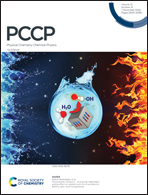End-capped group manipulation of non-fullerene acceptors for efficient organic photovoltaic solar cells: a DFT study†
Abstract
A series of acceptors, S1–S5, has been designed based on the acceptor–π–donor–π–acceptor (A–π–D–π–A) architecture by incorporating a phenothiazine unit as the central donor unit. Density functional theory (DFT) and time-dependent density functional theory (TD-DFT) methods have been employed to study the effect of various end-capped groups on the geometric, electronic, optical and charge transport properties of the designed acceptor molecules. The results reveal that on increasing the electron-withdrawing nature of the end-capped groups, the performance of the acceptor molecules increases. It is also observed that on increasing the flexibility of the end-capped groups, the planarity of the molecules gets destroyed and, as a result, the performance of the acceptor molecules decreases. The investigated molecules exhibit high electron affinity (EA) and low reorganization energy for electrons (λ−), indicating the electron acceptor nature of the designed molecules. The absorption properties of the molecules manifest that compounds S2–S4 possess high values of the maximum wavelength (λmax) of absorption. We have also studied the properties of a D/A active layer by considering PffBT4T-2OD as the electron donor and arranging PffBT4T-2OD/S1–S5 molecules in a face to face manner. Properties of the D/A blend indicate that molecules S2–S4 have capacity to promote charge carrier separation at the D/A active layer. Our results provide guidelines for further designing of acceptors to enhance the performance of organic solar cells (OSCs).

- This article is part of the themed collection: 2020 PCCP HOT Articles


 Please wait while we load your content...
Please wait while we load your content...